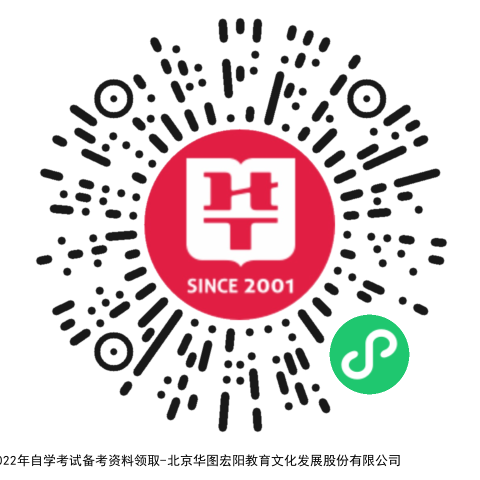2022-03-14 11:56:02 自学考试网
文章来源:华图教育


*资料包涵盖但不限于以上内容

保存小程序码至
手机进行扫码
【导读】华图自学考试频道同步华图教育发布:2022年4月自考英语二模拟练习题及答案4,详细信息请阅读下文!更多资讯请关注华图上学微信公众号(gh_77568f84fe68),欢迎大家电话咨询:17110152870 咨询自考报考问题。
★预留信息 学历提升报考问题免费咨询★
距离2022年4月自学考试开考还有一个月的时间,许多考生正在复习备考中,华图自考网为各位考生整理了2022年4月自考英语二模拟练习题及答案,供各位考生参考。
2022年4月自考00015英语二模拟试卷及答案4
Ⅰ. Choose the best answer for each blank (10 points, 1 point for each item) 从下列各句四个选项中选出一个最佳答案。(每小题1分,共10分)
1. The major classical approaches to management were systematic management, scientific management, administrative management, ______ , and bureaucracy.
A. social relations B. human relations
C. public relations D. mass relations
2. As managers rise through an organization, they must exercise their conceptual and decision skills with increasing ______.
A. time B. speed
C. frequency D. rate
3. Some problems that managers face demand immediate action, while others take months or even years to ______.
A. unfold B. ignore
C. disappear D. discover
4. ______ is the basic purpose of the organization and its scope of operation.
A. Task B. Commitment
C. Statement D. Mission
5. Leadership seems to be something that can be learned by anyone, taught to everyone, ______ to no one.
A. refused B. opposed
C. denied D. refuted
6. Good citizens of the organization are committed, satisfied ______ who perform above and beyond the call of duty by doing extra tasks that can help the company.
A. employees B. clerks
C. employers D. subordinates
7. All the previous management approaches focused on ways to increase the ______ and efficiency of labor.
A. product B. productivity
C. producing D. productive
8. Street stands are also ______ services whether they offer a wide variety of dishes to large numbers of people or only snacks for tourists.
A. expensive B. luxurious
C. convenience D. family type
9. Most properties now have computerized reservation systems that keep track of the ______ between rooms available and reservation requests.
A. difference B. stability
C. correspondence D. balance
10. There is a ______ difference between giving professional advice to a client and simply making a booking at the client's request.
A. consider B. considered
C. considerate D. considerable
Ⅱ. Cloze test (10 points, 1 point for each item) 下列短文中有十个空白,每个空白有四个选项,根据上下文要求选出最佳答案。(每小题1分,共10分)
The leader's job is to create a 11 . Until a few years ago, vision was not a word one heard managers utter. But today, having a vision for the future and 12 that vision to others are known to be essential 13 of great leadership. Some even maintain that if there is no vision, there is 14 business.
Business people are not alone in this belief. Leadership scholars also have brought vision to a 15 of prominence in management thinking. A vision is a 16 image of a possible and desirable future of the organization. Great leaders see in their vision what others have not thought of. They imagine an 17 future for their organizations that goes beyond the ordinary and 18 what others may have thought possible. They strive to realize significant achievements that others have not. In short, leaders must be 19 looking and clarify the directions in 20 they want their organizations to move.
( )11. A. situation B. site C. future D. vision
( )12. A. communicate B. communicating C. communicated D. communication
( )13. A. components B. factors C. reasons D. occasions
( )14. A. not B. no C. none D. any
( )15. A. post B. condition C. position D. behavior
( )16. A. mental B. heart C. thought D. mind
( )17. A. impractical B. ideal C. idea D. unbelievable
( )18. A. within B. along C. above D. beyond
( )19. A. forward B. upward C. downward D. backward
( )20. A. why B. that C. which D. what
Ⅲ. Reading comprehension (30 points, 2 points for each item) 阅读下列短文,根据短文,在每个问题后所给的四个选项中选出一个最佳答案。(每小题2分,共30分)
Passage One
Fortune recently identified the 10 companies it considers to be the best managed. Among the top 10, some of these firms and the attitudes of their leaders are as follows.
Wal-Mart CEO David Glass has a thorough knowledge of the business and a clear focus on its opportunities and hazards. He spends at least two full days every week visiting stores, asking clerks and customers for ideas and complaints. He modestly claims, “I'm nothing more than a representative of the collective efforts of our company's 350,000 associates”.
PepsiCo CEO Wayne Calloway spends about half his time on personnel matters. “I'm quite familiar with 650 people plus maybe another 200 to 300…I figure that the team that has the best athletes will eventually win the Super Bowl if the coach doesn't mess up too much.”
General Electric CEO John Welch, Jr., is pushing for employee support and rapid transfer of ideas among divisions. He is so passionate about managing that he fidgets on the edge of his seat when he talks about. “I don't ever read speeches. If I can't wring it from my gut…I don't know it. ”
21. Which of the following isn't true? ______
A. Fortune is the name of a newspaper.
B. Fortune recently picked out 10 companies that are best managed.
C. The attitudes of some of these companies' leaders are introduced in this passage.
D. Matters of management have a lot to do with the attitudes of leaders.
22. Which of the following cannot describe David Glass? ______
A. He is familiar with the business.
B. He cares about the development of the business.
C. He usually spends weekends with his clerks.
D. He values the suggestions from clerks and customers.
23. What does the word “associates” in the last sentence of the 2nd paragraph mean? ______
A. Players. B. Friends.
C. Employees. D. Associations.
24. What does Wayne Calloway believe? ______
A. Employees must obey their manager without question.
B. A manager must accept all his employees' ideas.
C. A manager must make every decision together with his employees.
D. The relationship between employees and their manager is similar to the relationship between athletes and their coach.
25. What is the common interest for all the three CEOs? ______
A. Employee support.
B. Friendship between clerks and customers.
C. Managers' timely response to problems.
D. Familiarity of employees with their work.
Passage Two
Communication is one of the most fundamental components of the manager's job. In a recent survey of 1,5000 senior executives from 20 countries, 89 percent saw communication as a key to CEO effectiveness in the year 2000. Managers spend most of their time communicating with others. Research confirms what any manager knows intuitively: communication competency is a fundamental aspect of job performance and managerial effectiveness.
Communication is the transmission of information and meaning from one party to another through the use of shared symbols. The sender initiates the process by conveying information to the receiver: the person for whom the message is intended. The sender has a meaning he or she wishes to communicate and encodes the meaning into symbols (e.g. the words chosen for the message). Then the sender transmits, or sends, the message through some channel, such as a verbal or written medium. Then the receiver decodes the message (e.g. reads it ) and attempts to interpret the sender's meaning. The receiver may provide feedback to the sender by encoding a message in response to the sender's message. The communication process often is hampered by noise, or interference, in the system that blocks perfect understanding. Noise could be anything that interferes with your attention to the conversation: ringing telephone, thoughts about other products you've considered, or simple fatigue or stress.
26. Managers ______ that communication competency is a key to job performance and managerial effectiveness.
A. don't know. B. try to understand
C. know intuitively D. don't believe
27. The word “party” in the 1st sentence of the 2nd paragraph means ______.
A. an occasion where people meet together
B. a group of people having the same political aims.
C. a person or a group of people taking part in an activity.
D. a social gathering for pleasure.
28. The word “send” cannot be replaced by ______.
A. receive B. convey
C. transmit D. deliver
29. To choose words for a message is to ______.
A. interpret the meaning of a message
B. encode the meaning into a message
C. decode a message
D. read a message
30. ______ isn't the main component of a communication process.
A. Sender and receiver B. Noise
C. Message
D. Channel
Passage Three
The visitor experience at attractions begins with anticipation. It may be stimulated by effective promotion, especially printed materials, and by personal recommendation. It begins in earnest at the entrance to the site. Every aspect of the experience visitors undergo is potentially under management control. In some historic buildings and sites the degree of management control is limited by planning and policy restrictions, but the essential components of the product may be summarized as follows:
● Quality of the advertising material and promotional literature, which establishes a promise and influences initial expectations of a visit.
● Effectiveness of signage that guides first-time visitors to a site or building
● First impression of a site and its perceived interest to prospective visitors, related to a pre-visit expectation. Efficiency of car or coach parking arrangements, and access to the entrance.
● Physical appearance and motivating appeal of the entrance to an attraction.
● Handling of visitors at the entrance or in a reception area including ticketing, information provided, and initial orientation at the point of sale or admission.
● Visitor circulation patterns on the site or building, managed through the logical layout of the resources elements, paths, signposting, and in other ways.
● Display, presentation, and interpretation of the main elements of the resources, including audio-visual materials and any events or activities provided.
● Location and layout of any subsidiary attractions on the site.
● Location and layout of facilities such as toilets, cafes, and shops.
It is helpful to assess these product elements, both separately and within the overall experience, as part of a bundle or package of components. The package may be varied by management decisions. Since one of the prime objects of attraction management is to generate motivation, customer satisfaction, and value for money, marketing inputs into product formulation will be crucial to success.
31. This passage is mainly about ______.
A. effective promotion
B. restrictions on planning historic buildings
C. the essential components of the product of an attraction
D. personal recommendation of an attraction
32. The word “signage” in the 2nd item of the summary means ______.
A. visitors' signatures B. a group of signs
C. visitors' expectations D. visitors' experiences
33. Toilets, cafes and shops are ______.
A. visitor circulation patterns B. assisting facilities
C. subsidiary attractions D. the main elements of resources
34. All these elements summarized in this passage are regarded as ______.
A. part of a package of components B. the whole package of components
C. more than a package of components D. the full range of the visitor experience
35. ______ isn't the prime object of attraction management. A. Customer interest B. Customer satisfaction
C. Marketing research D. Increase in profit
Ⅳ. Word spelling (20 points, 1 point for each item) 请将完整的单词写出。作为提示,每个单词的意义、词类及首字母均已给出(每小题1分,共20 分)
1. something handed down from an ancestor (n. ) l______
2. something that motivates effort (n. ) i______
3. to open or spread out (v. ) u______
4. a portable case for holding material, especially when representative of a person's work (n. ) p______
5. to persist in a purpose in the face of obstacles (v. ) p______
6. to give energy to (v. ) e______
7. doubtfulness as regards interpretation (n. ) a______
8. remaining in a place for only a brief time (adj. ) t______
9. to have an area in common with (v. ) o______
10. one that acts as an agent between persons or things (n. ) i______
11. deprivation of ownership especially for public use (n. ) e______
12. a heavy, coarse, closely woven fabric of cotton for tents (n. ) c______
13. insufficiency of amount (n. ) s______
14. to illustrate by example (v. ) e______
15. to give a false or misleading account of something (v. ) d______
16. having the quality to pervade (adj. ) p______
17. to strive to accomplish something (v. ) p______
18. to take on and wrestle with a problem (v. ) t______
19. to extend to disparate fields (v. ) d______
20. to prescribe with authority (v. ) d______
Ⅴ. Translation from Chinese into English (15 points, 3 points for each item) 将下列各句译成英语(每小题3 分,共15分)
1. 政府继续关注社会各个方面。
2. 主题将成为旅游点定位的基础。
3. 我们正生活在一个所有经济功能高度全球化的世界中。
4. 旅行代理人是旅游业最重要的成员之一。
5. 房间租赁是旅馆的主要业务。
Ⅵ. Translation from English into Chinese (15 points, 3 points for each item) 将下列各句译成汉语。(每小题3 分,共15分)
1. Organizational behavior draws from a variety of disciplines.
2. A manager usually cannot do the job alone or without adequate resources.
3. Risk exists when the probability of success is less than 100 percent.
4. Each major department should operate in a manner consistent with the business strategies of the organization.
5. Central to effective leadership is power-the ability to influence other people.
| ↓↓↓↓2022年全国自学考试相关推荐↓↓↓↓ | |||
| 2022自考 报考指南 |
2022自考 备考资料 |
2022自考 公告解读 |
2022自考 咨询答疑 |
相关内容推荐:
2022年10月全国自学考试报名公告汇总
2022年10月各省自考报名时间及入口汇总
2022年10月自考备考复习模拟题汇总
2022年全国自考考试时间及课程安排汇总
2022年10月全国自考准考证打印入口汇总

微信公众号

自考备考群